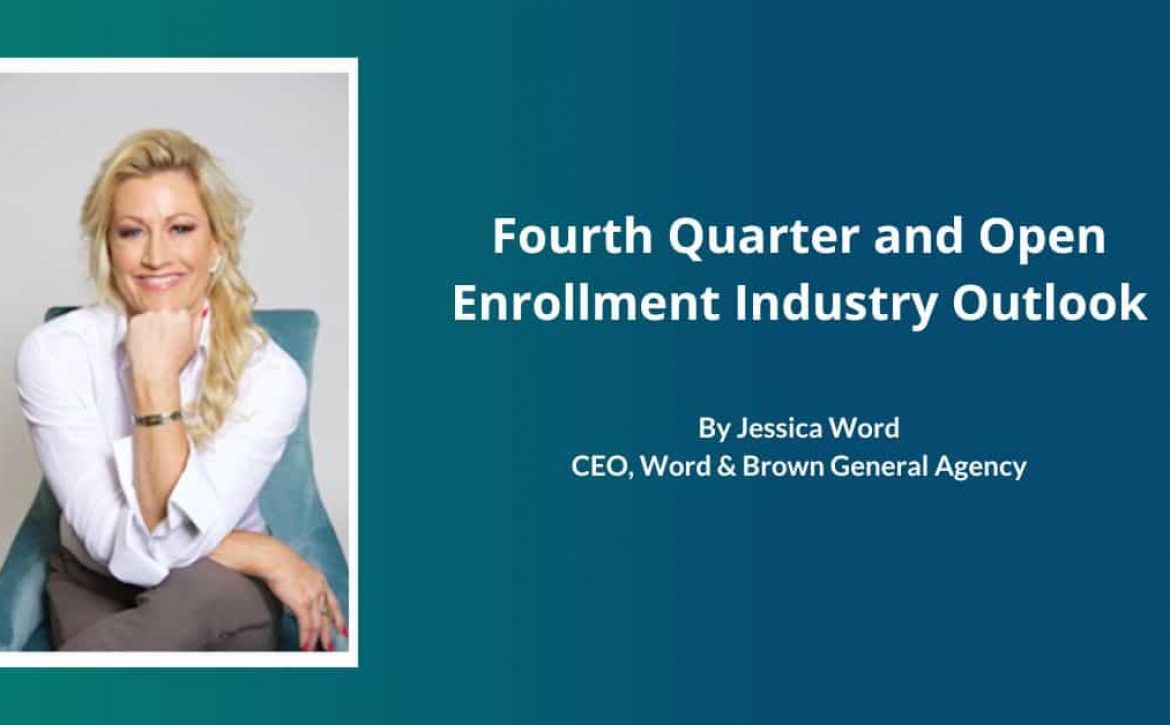By Jessica Word
CEO, Word & Brown General Agency
Open enrollment is just around the corner – and all of us in the health insurance space are about to get a lot busier!
As we meet with clients in the next month to review existing coverage, discuss any adjustments or new benefits, keep an eye on the following trends – they will set you and your team up for a successful fourth quarter.
Leverage the expertise of others
While we all like our solitude now and again, it can be challenging even for the most seasoned broker to work without any input from others. That’s what it’s important to leverage the knowledge and experience of team members, colleagues, and co-workers – they can help problem-solve, share what they are hearing from their clients, share insights into best practices and more.
Partners can also help. For example, our Word & Brown team knows brokers appreciate the efforts we make to help their business operations run smoothly and be more productive. In fact, we are committed to helping our broker clients get more time back in their day through tools ranging from online dashboards to downloadable tools.
The bottom line here is to not be shy in asking for input and advice. Your partners and colleagues are all willing to help – your success is good for everyone.
Digital experiences are here to stay
When the pandemic shut down in-person corporate America in 2020, very few of us successfully predicted that our efforts to deliver meaningful digital experiences would forever transform how we work with brokers.
A remote deployment strategy is now common in the health insurance space. Many companies, including us, have committed to a digital transformation of our internal processes to increase efficiency and streamline operations. This also means remaining open and adaptive to the continuing need for videoconferencing and collaborative workflow platforms. While “Zoom fatigue” is something we can all relate to, there’s no putting the proverbial genie back in the bottle – it is the new conference call.
Adapting and improving your client’s digital experience is key to providing stellar and invaluable customer service to better support them year around.
Thoughtfully invest in technology
Demand to handle services remotely, such as quoting and enrollment, will continue to rise. Brokers will seek out outside resources and struggle to stay on top of constantly shifting technological advances. Whether that means integrating a quoting engine, or enrollment management into an online portal, investment in technology is essential to a brokers’ servicing division.
It’s important to be thoughtful when investing in technology solutions. Digital tools that can eliminate account management and online enrollment burdens may prove cumbersome integrating with existing systems and software; or a new offering might assume that its API will work within your system platform when it can’t.
The bottom line is that you must treat new technology as you would any capital improvement. Tap opinions of your IT team, but also make sure to gather opinions of other brokers by taking advantage of shared knowledge provided by groups such as SAHU.
Ongoing legislative and compliance challenges
We all will continue to face new legislation and compliance burdens, especially related to the impact of the COVID-19 employer and employee mandates. For example, the Occupational Safety and Health Administration (OSHA) rolled back the Biden administration’s COVID-19 vaccine mandate for companies with more than 100 employees earlier this year. Clients will need guidance, and brokers need to stay updated on these changing policies to remain trusted counselors.
The topic of single-payer healthcare will continue to come up in conversation. Even though Assembly bill 1400 (the single-payer healthcare proposal), did not advance in the state assembly, as healthcare experts we must remain a part of this important conversation with legislators and policymakers. Our community needs to continue demonstrating our commitment to make healthcare more accessible for all, while not depending 100% on the government to uproot a system that works for an overwhelming majority of Californians. We must be advocates for options: from employer-sponsored and private health coverage to government subsidized options through Covered California, Medi-Cal, or Medicare.
Lastly, a new compensation disclosure for brokers just became effective late last year. The Department of Labor and Employee Benefits Security Administration released long-awaited guidance to help brokers better understand the new disclosure requirements and the impact they have on their client groups. The good news: there are resources available to help break down what this means for brokers and customers. Your colleagues and partners can help!
Meet clients and team members where they are
While you and your team might be back in the office, clients might now prefer to work from home or only come into the office a couple of days a week themselves. Everyone on your team needs to understand it’s time to put the client first when it comes to how and when to meet. In setting meetings, the question to ask now is “do you prefer in-person or virtual?” — giving them the choice.
It’s important to show clients you’re okay with letting them set the parameters. Flexibility is key, especially since everyone now knows that setting up Zoom or Teams meetings is as easy as scheduling a conference call.
The same goes for your team. Make sure to regularly check in with your team members either in person or virtually. Remind your team that you are available to talk through any problems (and possible solutions) as they arrive.
So, as you prepare for the busy open enrollment season, make sure to leverage your partners’ expertise, and recognize the importance of digital expansion and technology investment for an increasingly online future. Additionally, legislative and compliance challenges will continue to impact how brokers advise and serve employers of all sizes. Finally, meet clients and team members where they are – this sets you up as a valued broker and internal team leader, increasing the potential for a successful fourth quarter.
Keeping an eye on all these issues and pivoting, as needed, helps us increase the value that we offer to businesses to help them to succeed throughout open enrollment and beyond.
Jessica Word is CEO of Word & Brown General Agency. Established in 1985 and headquartered in Orange, Calif., Word & Brown is one the state’s largest independently owned general agents. For additional information, visit www.wordandbrown.com.





